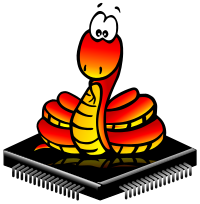MicroPython
 | |
| Original author(s) | Damien George |
|---|---|
| Initial release | 3 May 2014 |
| Stable release | 1.10
/ 24 January 2019 |
| Repository | |
| Written in | C |
| Platform | Micro Bit, Arduino, ESP8266, ESP32,STM32 |
| Type | Python implementation |
| License | MIT license[1] |
| Website | micropython |
MicroPython[2] is a software implementation of the Python 3 programming language, written in C, that is optimized to run on a microcontroller.[3][4] MicroPython is a full Python compiler and runtime that runs on the micro-controller hardware. The user is presented with an interactive prompt (the REPL) to execute supported commands immediately. Included are a selection of core Python libraries; MicroPython includes modules which give the programmer access to low-level hardware.[2]
MicroPython was originally created by the Australian programmer and physicist Damien George, after a successful Kickstarter backed campaign in 2013.[5] While the original Kickstart campaign released MicroPython with a pyboard microcontroller, MicroPython supports a number of ARM based architectures.[6] MicroPython has since been run on Arduino platform based products,[7][8] ESP8266,[9] ESP32,[10] and Internet of things[11][12][13][14] hardware. In 2016 a version of MicroPython for the BBC Micro Bit was created as part of the Python Software Foundation's contribution to the Micro Bit partnership with the BBC.[15]
In 2017, Microsemi made a MicroPython port for RISC-V (RV32 and RV64) architecture.[16]
The source code for the project is available on GitHub.[17]
References
- ^ George, Damien P. (4 May 2014). "micropython/LICENSE at master · micropython/micropython". GitHub. Retrieved 11 February 2017.
{{cite web}}: Cite has empty unknown parameter:|dead-url=(help) - ^ a b "MicroPython - Python for microcontrollers". micropython.org. Retrieved 12 August 2017.
- ^ Venkataramanan, Madhumita (6 December 2013). "Micro Python: more powerful than Arduino, simpler than the Raspberry Pi". Wired. Retrieved 15 December 2016.
- ^ Yegulalp, Serdar (5 July 2014). "Micro Python's tiny circuits: Python variant targets microcontrollers". InfoWorld. Retrieved 15 December 2016.
- ^ "Micro Python: Python for microcontrollers". Kickstarter. Kickstarter. Retrieved 15 December 2016.
- ^ Beningo, Jacob (11 July 2016). "Prototype to production: MicroPython under the hood". EDN Network. Retrieved 15 December 2016.
- ^ Horsey, Julian (12 October 2016). "Pyduino Arduino Based Development Board That Supports MicroPython (video)". Geeky Gadgets. Retrieved 15 December 2016.
- ^ Beningo, Jacob (6 April 2016). "Getting Started with Micro Python". EDN Network. Retrieved 15 December 2016.
- ^ Williams, Elliot (21 July 2016). "MicroPython on the ESP8266: Kicking the Tires". Hackaday. Retrieved 15 December 2016.
- ^ "MicroPython ported to the ESP32". GitHub. Retrieved 8 March 2017.
- ^ "MicroPython on the ESP8266: beautifully easy IoT". Kickstarter. Kickstarter. Retrieved 6 December 2017.
- ^ "MICROPYTHON BRINGING PYTHON TO THE INTERNET OF THINGS". MICROPYTHON BRINGING PYTHON TO THE INTERNET OF THINGS. github.io. Retrieved 6 December 2017.
- ^ "FiPy – The world's first 5-network IoT dev board". Kickstarter. Retrieved 15 December 2016.
- ^ "Pycom Incorporating Sequans LTE-M Technology in New 5-Network IoT Development Board". Business Wire. 22 November 2016. Retrieved 15 December 2016.
- ^ Williams, Alun. "Hands on with the BBC Micro-Bit user interface". ElectronicsWeekly.com. Retrieved 8 July 2015.
- ^ "RISC-V Poster Preview — 7th RISC-V Workshop" (PDF). 28 November 2017. Retrieved 17 December 2018.
- ^ "MicroPython on GitHub".
External links
- Official website
- micropython on GitHub
- GOTO 2016 • MicroPython & the Internet of Things • Damien George on YouTube
- MicroPython playlist on YouTube • Tutorials by Tony DiCola / Adafruit

